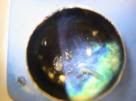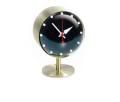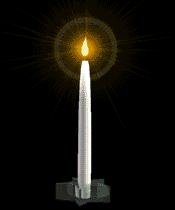
Are you afraid at night? You should be. Dread of nighttime (in the extreme, noctiphobia) is one of the first learned fears most children develop. Catholics even have a hermit patron saint, St. Giles, who protects against the fear of the night.
 Early man knew danger – even death itself – ruled the land once his warm, life-sustaining sun slipped below the horizon. Strange nocturnal creatures with huge eyes appeared and roamed the earth foraging for food. Large, predatory animals hunted weaker beings at night. In the night sky, distant pairs of bright eyes belonging to – who, or what -- opened and waited to claim an overconfident youth or unwatched child who wandered away from the minimal safety of the rocky shelter. Eerie mists clung to low lying areas, moving along the ground as if alive. Daylight hours were safer; nighttime was often inexplicable.
Early man knew danger – even death itself – ruled the land once his warm, life-sustaining sun slipped below the horizon. Strange nocturnal creatures with huge eyes appeared and roamed the earth foraging for food. Large, predatory animals hunted weaker beings at night. In the night sky, distant pairs of bright eyes belonging to – who, or what -- opened and waited to claim an overconfident youth or unwatched child who wandered away from the minimal safety of the rocky shelter. Eerie mists clung to low lying areas, moving along the ground as if alive. Daylight hours were safer; nighttime was often inexplicable.  Human earthlings learned to use fire, and new anxieties about nighttime were spawned. The light blazed then dimmed, only to flare again. Inky shadows retreated and encroached. Huge distorted, caliginous creatures danced inside the cave, surrounding the people and teasing the light with their dark tauntings. They danced, shifting and surging forward as the fire died down, threatening to swallow the unsuspecting – reminding man that darkness, danger, and death rule the night.
Human earthlings learned to use fire, and new anxieties about nighttime were spawned. The light blazed then dimmed, only to flare again. Inky shadows retreated and encroached. Huge distorted, caliginous creatures danced inside the cave, surrounding the people and teasing the light with their dark tauntings. They danced, shifting and surging forward as the fire died down, threatening to swallow the unsuspecting – reminding man that darkness, danger, and death rule the night. Long hours spent watching Light and Darkness fight their never-ending battles provided opportunities for men to compare notes with others regarding his knowledge of the night and its denizens. We understand according to our abilities. Man was incapable of understanding why nocturnal animals have proportionally larger eyes than humans do, or why their eyes seemed to glow. He didn't know these creatures were designed with a tapetum, a mirror-like membrane which reflects light that has already passed through the retina back through the retina a second time, providing the light source with another opportunity to strike the light-sensitive rods (photosensitive cells of the eye). Man did understand he was more vulnerable at night than during the day. Marauders often attacked under cover of darkness, stealing hard-earned resources and inflicting bodily injury. These concerns remain, eons later.
Long hours spent watching Light and Darkness fight their never-ending battles provided opportunities for men to compare notes with others regarding his knowledge of the night and its denizens. We understand according to our abilities. Man was incapable of understanding why nocturnal animals have proportionally larger eyes than humans do, or why their eyes seemed to glow. He didn't know these creatures were designed with a tapetum, a mirror-like membrane which reflects light that has already passed through the retina back through the retina a second time, providing the light source with another opportunity to strike the light-sensitive rods (photosensitive cells of the eye). Man did understand he was more vulnerable at night than during the day. Marauders often attacked under cover of darkness, stealing hard-earned resources and inflicting bodily injury. These concerns remain, eons later. Unidentifiable noises feel more threatening when filtered through the night air. We wonder, what could be out there? Dangerous animals and bandits are tangible. But what about magical, mythical and folkloric creatures such as pixies, fairies, vampires, werewolves, and ghosts – of which are believed to wander primarily at night? Nearly every culture relates stories and legends warning of nighttime dangers due to these anomalous creatures. Norse legend says that Nótt (the personification of Night) is the mother of a daughter (Earth) and a son (Day). Earth obeys her mother Nótt – at least while Mom's awake.
Unidentifiable noises feel more threatening when filtered through the night air. We wonder, what could be out there? Dangerous animals and bandits are tangible. But what about magical, mythical and folkloric creatures such as pixies, fairies, vampires, werewolves, and ghosts – of which are believed to wander primarily at night? Nearly every culture relates stories and legends warning of nighttime dangers due to these anomalous creatures. Norse legend says that Nótt (the personification of Night) is the mother of a daughter (Earth) and a son (Day). Earth obeys her mother Nótt – at least while Mom's awake. Today, we're not safe in our own homes, even with the doors and windows locked. Death still finds a way over the transom and visits man more often at night from the time we're born up into old age. As a former nurse who worked both pediatrics and terminal care, I know people die at any time – but by far, most people who expire** take place during the wee hours of the night. It's as though the body slows and calms at night, lowering defenses against that slippery scythe bearer, Death. (**Expire: The hospital term used when a patient dies. I know it sounds like they forgot to feed their parking meter; maybe in some esoteric way, they do)
Today, we're not safe in our own homes, even with the doors and windows locked. Death still finds a way over the transom and visits man more often at night from the time we're born up into old age. As a former nurse who worked both pediatrics and terminal care, I know people die at any time – but by far, most people who expire** take place during the wee hours of the night. It's as though the body slows and calms at night, lowering defenses against that slippery scythe bearer, Death. (**Expire: The hospital term used when a patient dies. I know it sounds like they forgot to feed their parking meter; maybe in some esoteric way, they do) Being Born At Night May Cause Death: A Stanford University study released in August 2005 analyzed records of more than 3.3 million babies born in California between 1992 and 1999. It suggested babies born at night had a 12-16% increase in neonatal mortality (babies who die before they reach 28 days of age), accounting for nearly 10% of all neonatal deaths in that state. Personally, I believe these statistics are a direct result of hospital birthing. The stats did not take into account at-home or birth center births. It is universally accepted that midnight shift hospital staff demonstrate increased physical and mental fatigue and often, less experienced staff are assigned to the less-desirable 11-7 schedule. Additionally, it's not unusual for obstetricians ("OB doctors"/surgeons specializing in the female reproductive system) to have worked through a complete daytime shift. Historically, no wisdom from our ancestors suggests that babies born at night are more likely to die during the first month of life than were babies born during daytime.
Being Born At Night May Cause Death: A Stanford University study released in August 2005 analyzed records of more than 3.3 million babies born in California between 1992 and 1999. It suggested babies born at night had a 12-16% increase in neonatal mortality (babies who die before they reach 28 days of age), accounting for nearly 10% of all neonatal deaths in that state. Personally, I believe these statistics are a direct result of hospital birthing. The stats did not take into account at-home or birth center births. It is universally accepted that midnight shift hospital staff demonstrate increased physical and mental fatigue and often, less experienced staff are assigned to the less-desirable 11-7 schedule. Additionally, it's not unusual for obstetricians ("OB doctors"/surgeons specializing in the female reproductive system) to have worked through a complete daytime shift. Historically, no wisdom from our ancestors suggests that babies born at night are more likely to die during the first month of life than were babies born during daytime.Sudden Infant Death Syndrome (abbreviated SIDS, and also known as crib death): A healthy infant is put to bed and later found dead for no apparent reason. Although medical research continues to pose a number of theories, a definitive answer remains elusive. My research through the past twenty years suggests that infants who sleep in their parents' beds almost never fall victim to SIDS, the one exception being if the parents are under the influence of drugs or alcohol. Infants have been known to die of suffocation when an impaired parent rolls over. To my knowledge, death has never been proven to occur with an unaffected parent.
Stroke: A stroke is the sudden death of cells in part of the brain, caused by reduced flow of blood to the brain. More than half a million people in the U.S. experience a stroke every year. Stroke is the third leading cause of death, and the number one cause of disability in this country. Cerebral thrombosis is a form of stroke that occurs when a blood clot forms within the brain. Cerebral thromboses occur more often at night, or very early in the morning.
Asthma: 53% of asthma deaths occur during nighttime hours, most particularly the four hours prior to sunrise.
Obstructive Sleep Apnea: Generally, most cardiac patients expire during daylight hours. However, a study in Minnesota conducted from 1987 to 2003 (directed by Virend Somers, M.D.,PhD, a Mayo Clinic cardiologist) revealed that 54% of the patients with obstructive sleep apnea who died suddenly of cardiac causes, died between 10p.m. and 6a.m.
And now Danylo Burdenko claims "The New Black Death," ær sepsis noctus (dark air found within the upper atmosphere), is the leading cause of death in the human species. He further asserts that "at certain times of the year, at certain latitudes, 100% of human mortality occurs during night's darkness." Burdenko examined death certificates of 20 million people from 18 countries who died between 1900 and 2000. Read the paper for more information (http://thescienctist.org/papers/20030715.pdf. I could find no other Internet reference about ær sepsis noctus).
 According to Wikipedia, on average nights are shorter than days -- only a few ticks of the clock shorter, but when your heart beats like a jackhammer inside your chest and flop sweat trickles down your back, every second matters. So dig out your St. Giles medal; The Horror Library's Fresh Meat for July is finally rotting on the slab and the Slushpile is still smoldering. What are you waiting for?
According to Wikipedia, on average nights are shorter than days -- only a few ticks of the clock shorter, but when your heart beats like a jackhammer inside your chest and flop sweat trickles down your back, every second matters. So dig out your St. Giles medal; The Horror Library's Fresh Meat for July is finally rotting on the slab and the Slushpile is still smoldering. What are you waiting for? When you get there, tell 'em Clara sent ya.
© 2006 Clara Chandler - All Rights Reserved

No comments:
Post a Comment